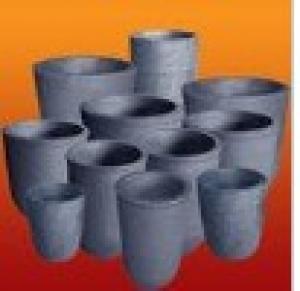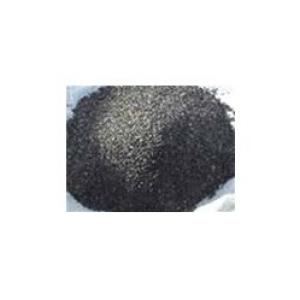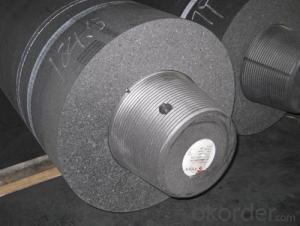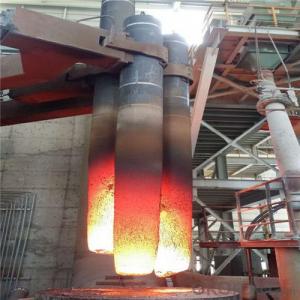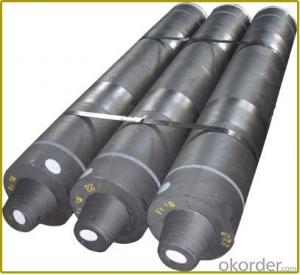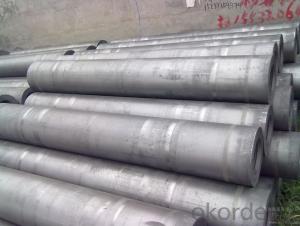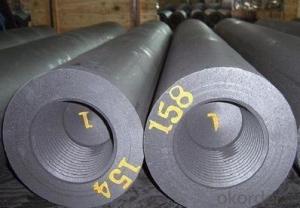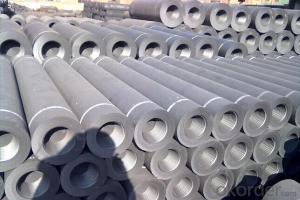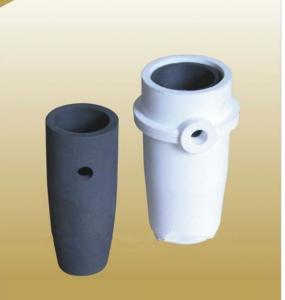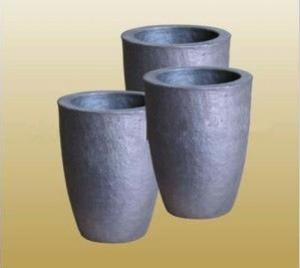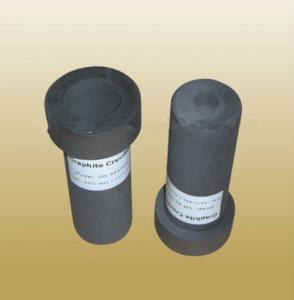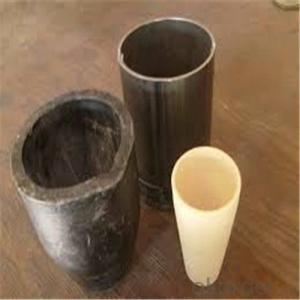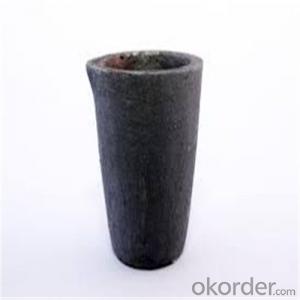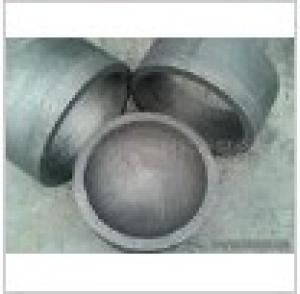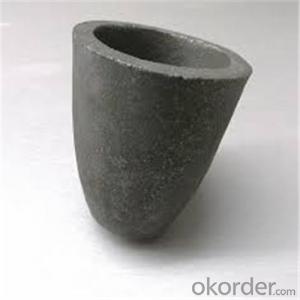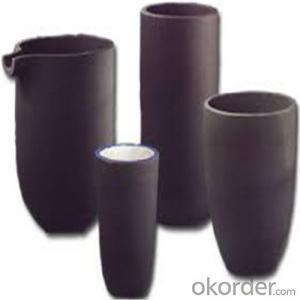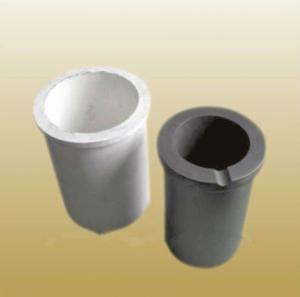Graphite Crucible Black
- Loading Port:
- China Main Port
- Payment Terms:
- TT or LC
- Min Order Qty:
- 1 Set pc
- Supply Capability:
- 5000 Sets per Month pc/month
OKorder Service Pledge
Quality Product, Order Online Tracking, Timely Delivery
OKorder Financial Service
Credit Rating, Credit Services, Credit Purchasing
You Might Also Like
Detailed Product Description
graphite crucible is featured by fast heat conduction,long service life and low cost and the product finds good application
1.Garphite crucible can withstand the high temperature, an has good resistance to chemical erosions and thermal shock.
2.Graphite crucible is ideal for the melting of gold,silver,aluminum,copper and other metals and is also used as a tool for smelting jewelry.
- Q:Can a graphite crucible be used for melting magnetic materials?
- Using a different grammatical structure and expressions: It is not possible to use a graphite crucible for melting magnetic materials. Graphite, being a non-magnetic substance, lacks the capacity to create or maintain a magnetic field. Consequently, it is unsuitable for melting magnetic materials as it cannot effectively engage with or confine them.
- Q:How do you prevent graphite crucibles from sticking to the melted material?
- To prevent graphite crucibles from sticking to the melted material, there are several steps that can be taken: 1. Apply a release agent: Before placing the material in the crucible, a thin layer of a release agent can be applied to the inside surface of the crucible. This can be done using a brush or spray. The release agent acts as a barrier between the crucible and the melted material, preventing them from sticking together. 2. Preheat the crucible: Prior to adding the material, preheating the graphite crucible can help reduce the chances of sticking. Heating the crucible to a temperature slightly higher than the melting point of the material can create a thermal barrier that prevents the material from adhering to the crucible. 3. Use flux: In some cases, the addition of a flux can help prevent sticking. Flux is a chemical compound that lowers the melting point of the material and facilitates its flow. It can also act as a protective barrier between the crucible and the melted material, preventing them from sticking together. 4. Control the temperature: It is important to maintain the proper temperature throughout the melting process. If the temperature is too high, it can cause the material to become more reactive with the crucible, leading to sticking. Conversely, if the temperature is too low, the material may not fully melt, increasing the chances of sticking. Following the recommended temperature range for the material being melted can help prevent sticking. 5. Properly clean and maintain the crucible: Regularly cleaning the crucible after each use is essential to prevent buildup or contamination that can lead to sticking. It is important to remove any residual material or debris from the crucible using appropriate cleaning methods. Additionally, inspecting the crucible for any signs of wear or damage and replacing it when necessary can help prevent sticking. By following these preventive measures, the risk of graphite crucibles sticking to the melted material can be significantly minimized, ensuring a smooth and efficient melting process.
- Q:What are the different methods of preventing oxidation in a graphite crucible?
- There are various techniques available to prevent oxidation in a graphite crucible. 1. Coating: An effective approach involves the application of a protective coating on the inner surface of the crucible. This coating acts as a barrier, preventing direct contact between the crucible and the oxidizing atmosphere. Refractory materials like zirconium oxide or alumina are commonly used for this purpose. 2. Preheating: Another method that works well is preheating the crucible prior to use. Subjecting the graphite crucible to high temperatures helps eliminate any impurities or volatile substances present, leaving behind a more stable and less vulnerable surface. This aids in minimizing oxidation during subsequent use. 3. Vacuum or inert gas environment: Performing operations within a vacuum or an inert gas environment, such as argon or nitrogen, can significantly reduce the likelihood of oxidation. These environments lack oxygen, which is necessary for oxidation to occur. By eliminating or reducing the presence of oxygen, the graphite crucible remains shielded from oxidation. 4. Temperature control: Properly managing the temperature also plays a crucial role in preventing oxidation in a graphite crucible. Excessive and prolonged exposure to high temperatures can accelerate oxidation. By maintaining the temperature within a specific range and avoiding abrupt temperature changes, oxidation can be kept to a minimum. 5. Regular cleaning and maintenance: Lastly, regular cleaning and maintenance of the crucible are imperative to prevent oxidation. Removing any accumulated contaminants or residues from the surface helps preserve the integrity of the crucible and safeguards against oxidation during subsequent use. It is important to consider that the choice of method may vary depending on the specific application and requirements. Factors such as the nature of the materials being processed, the operating conditions, and the desired level of protection against oxidation should be taken into account when selecting an appropriate method.
- Q:How does the erosion resistance of graphite affect the performance of a crucible?
- The erosion resistance of graphite plays a significant role in determining the performance of a crucible. Graphite is known for its excellent erosion resistance, which refers to its ability to withstand the wearing away or gradual destruction caused by various factors such as heat, chemicals, and mechanical forces. In the context of a crucible, which is a vessel used for melting and holding substances at high temperatures, erosion resistance is crucial for maintaining the integrity and longevity of the crucible. The erosion resistance of graphite ensures that the crucible can withstand the harsh conditions it is exposed to during the melting process. Firstly, the erosion resistance of graphite helps to prevent the crucible from deforming or cracking under high temperatures. Graphite has a high melting point and can withstand extreme heat, which makes it an ideal material for crucibles. Without erosion resistance, the crucible would be prone to thermal shock, resulting in cracking or failure. Secondly, erosion resistance is important for preserving the chemical stability and purity of the crucible. Graphite is chemically inert, meaning it does not react with most substances. This property allows the crucible to hold a wide range of materials without the risk of contamination. Additionally, the erosion resistance of graphite ensures that there is minimal loss of graphite particles into the molten materials, preventing impurities from being introduced into the final product. Furthermore, the erosion resistance of graphite contributes to the crucible's durability and overall performance. Graphite crucibles are often subjected to mechanical stresses, such as stirring or pouring of molten substances. The erosion resistance of graphite prevents the crucible from wearing away or deteriorating over time, ensuring that it can be used repeatedly without compromising its functionality. In summary, the erosion resistance of graphite is crucial for the performance of a crucible. It helps to maintain the structural integrity, withstand high temperatures, preserve chemical stability, and enhance the durability of the crucible. Without erosion resistance, the crucible would be prone to failure, leading to potential contamination, loss of material, and reduced lifespan.
- Q:What is the use of graphite for corrosion resistance?
- Made of graphite crucibles; used for melting aluminium. Graphite electrode.
- Q:Are there any safety precautions to take when using a graphite crucible?
- Yes, there are several safety precautions to take when using a graphite crucible. Firstly, it is important to always wear proper personal protective equipment (PPE) such as heat-resistant gloves, safety goggles, and a lab coat to protect against heat and potential splashes. Additionally, one should ensure that the crucible is not cracked or damaged before use, as this may lead to thermal shock and breakage during heating. When handling or transporting a hot crucible, using appropriate tongs or tools is crucial to avoid burns or accidents. It is also important to be aware of the proper temperature range for the crucible and avoid exceeding its maximum temperature limit, as this can cause it to degrade or break. Finally, always allow the crucible to cool down sufficiently before handling it after use to prevent burns.
- Q:When decomposing iron ore, why should it be carried out at low temperature?
- Because the iron ore inside the FeCl3, Yi Shenghua, most of the more than 100 degrees Celsius will evaporate into the air, so it is low temperature decomposition.
- Q:How do you determine the appropriate crucible material for a specific application?
- To determine the appropriate crucible material for a specific application, several factors need to be considered. Firstly, it is important to evaluate the temperature range of the application. Different crucible materials have different temperature limitations. For high-temperature applications, materials such as graphite or refractory metals like tungsten or molybdenum may be suitable, while for lower temperature applications, materials like porcelain or alumina may be sufficient. Secondly, the chemical compatibility of the crucible material with the substances being used in the application needs to be assessed. Certain materials may react with specific chemicals or gases, leading to contamination or degradation of the crucible. It is crucial to select a material that is chemically inert or resistant to the substances being used. Thirdly, the thermal conductivity and thermal shock resistance of the crucible material should be taken into account. Some applications require rapid heating and cooling cycles, which can cause thermal stress on the crucible. Materials with high thermal shock resistance, such as quartz or boron nitride, may be more suitable in such cases. Moreover, the mechanical strength and durability of the crucible material should be considered. Some applications involve mechanical forces, stirring, or pouring of molten materials, which can subject the crucible to physical stress. Materials like silicon carbide or stainless steel offer good mechanical strength and can withstand such conditions. Lastly, the cost and availability of the crucible material should be considered. Some materials, such as platinum or iridium, may offer excellent performance but can be expensive and difficult to procure. It is important to strike a balance between performance and cost-effectiveness. In conclusion, determining the appropriate crucible material for a specific application requires considering factors such as temperature range, chemical compatibility, thermal conductivity and shock resistance, mechanical strength, and cost. By carefully evaluating these factors, one can select a crucible material that will meet the requirements of the application effectively.
- Q:Is it possible to cast or mold materials using a graphite crucible?
- Yes, it is possible to cast or mold materials using a graphite crucible. Graphite crucibles are widely used in various industries, including foundries, jewelry making, and metal casting. Graphite has high thermal conductivity and can withstand high temperatures, making it an ideal material for melting and casting processes. It is commonly used for melting metals, alloys, and other materials that require high heat resistance. The graphite crucible provides a controlled environment for the molten material, ensuring efficient and precise casting or molding.
- Q:How does the surface tension of graphite affect crucible performance?
- The surface tension of graphite can have a significant impact on crucible performance. Graphite is known for its high surface tension, which refers to the ability of a liquid or solid to minimize its surface area by forming droplets or a curved surface. This property is crucial in crucible performance as it affects the wettability, thermal conductivity, and erosion resistance of the graphite material. Firstly, the surface tension of graphite affects its wettability with molten metals or other materials being processed in the crucible. High surface tension allows the graphite crucible to repel or resist wetting by the molten material, preventing it from sticking to the crucible walls. This is particularly important in processes such as melting or pouring metals, where the crucible needs to facilitate easy release of the molten material without any adherence or contamination. Secondly, surface tension plays a role in thermal conductivity within the crucible. Graphite has excellent thermal conductivity, and its high surface tension ensures that the heat is efficiently distributed throughout the crucible. This uniform heat distribution helps in maintaining a consistent temperature profile, reducing thermal gradients, and ensuring a more effective and controlled processing of materials. Lastly, the surface tension of graphite affects its erosion resistance, which is crucial for the crucible's longevity. The high surface tension of graphite enables it to resist erosion caused by the molten materials or any mechanical forces acting upon it. This property helps in preventing wear and tear, maintaining the structural integrity of the crucible, and prolonging its lifespan. In conclusion, the surface tension of graphite significantly affects crucible performance. It influences the wettability, thermal conductivity, and erosion resistance of the graphite material, ensuring efficient material release, uniform heat distribution, and long-lasting crucible durability.
Our products are sold all over the country, and exported to America, Germany, Spain, India, Japan and Korea. Besides, we have strict management and advanced production technology.
We promise we will win more clients and a larger market with honest commercial credit, high quality of products, competitive price and good service.
1. Manufacturer Overview |
|
|---|---|
| Location | Inner Mongolia,China (Mainland) |
| Year Established | 2006 |
| Annual Output Value | US$2.5 Million - US$5 Million |
| Main Markets | 7.14% North America 7.14% South America 7.14% Eastern Europe 7.14% Southeast Asia 7.14% Africa 7.14% Oceania 7.14% Mid East 7.14% Eastern Asia 7.14% Western Europe 7.14% Central America 7.14% Northern Europe 7.14% Southern Europe 7.14% South Asia 7.14% Domestic Market |
| Company Certifications | |
2. Manufacturer Certificates |
|
|---|---|
| a) Certification Name | |
| Range | |
| Reference | |
| Validity Period | |
3. Manufacturer Capability |
|
|---|---|
| a)Trade Capacity | |
| Nearest Port | Xingang,Tianjin |
| Export Percentage | 31% - 40% |
| No.of Employees in Trade Department | 21-50 People |
| Language Spoken: | English, Chinese |
| b)Factory Information | |
| Factory Size: | 1,000-3,000 square meters |
| No. of Production Lines | 7 |
| Contract Manufacturing | 1,000-3,000 square meters |
| Product Price Range | Low and/or Average |
Send your message to us
Graphite Crucible Black
- Loading Port:
- China Main Port
- Payment Terms:
- TT or LC
- Min Order Qty:
- 1 Set pc
- Supply Capability:
- 5000 Sets per Month pc/month
OKorder Service Pledge
Quality Product, Order Online Tracking, Timely Delivery
OKorder Financial Service
Credit Rating, Credit Services, Credit Purchasing
Similar products
New products
Hot products
Hot Searches
Related keywords
